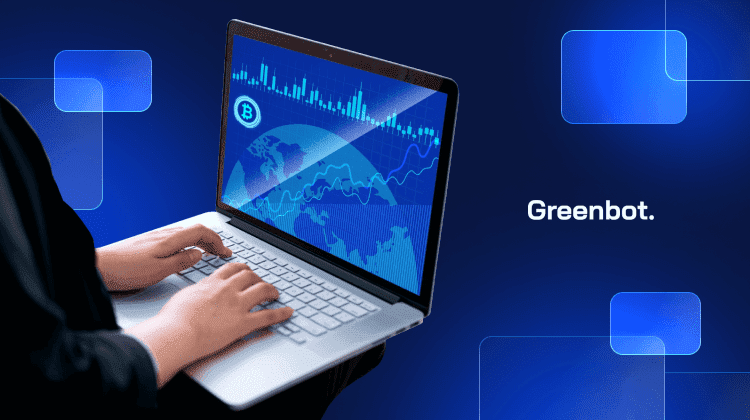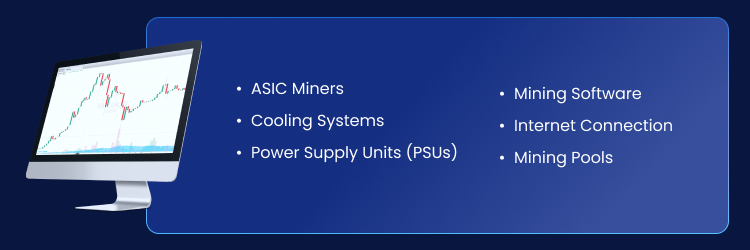
Mining Bitcoin at home is a practical way to earn cryptocurrency without purchasing it outright. For beginners wondering how you mine Bitcoin at home, this method is appealing because it allows you to support the Bitcoin blockchain while potentially earning rewards. With the right setup, you can start mining and actively participate in the crypto ecosystem.
However, mining Bitcoin at home comes with challenges. High electricity costs and competition from industrial miners can make profitability difficult. Careful planning, energy-efficient equipment, and access to affordable power are essential for making home Bitcoin mining a rewarding endeavor.
What Is Crypto Mining?

Crypto mining is the process that keeps blockchain networks like Bitcoin running smoothly. It verifies and records transactions on a secure, decentralized blockchain ledger. Unlike traditional systems run by banks, Bitcoin relies on miners worldwide to manage and secure the network. Miners use powerful hardware to solve puzzles that validate transactions. In return, they earn Bitcoin, which keeps the system functional and rewards their efforts.
The decentralized nature of Bitcoin mining makes it unique. There’s no central authority, so miners are responsible for securing the network and preventing fraud, such as double-spending. This system ensures transparency and fairness for everyone using the blockchain. Through the proof-of-work (PoW) process, miners safeguard the network from tampering or attacks. Without them, cryptocurrencies like Bitcoin wouldn’t work, as mining is essential for maintaining trust and reliability in the system.
How Bitcoin Mining Works
Bitcoin mining involves solving complex puzzles to confirm transactions and secure the blockchain. These puzzles produce a unique 64-character output called a hash, representing data from a transaction block. Miners compete to generate a hash lower than the target set by the network. To do this, they repeatedly adjust a value called the nonce until they find a solution. Once the correct hash is found, the miner earns a reward in Bitcoin, and the block is added to the blockchain.
To begin, set up a crypto wallet to store your earnings. You’ll need specialized hardware, such as ASIC miners, and mining software to connect to the network. Joining a mining pool is crucial for small-scale miners, as pooling resources with others significantly increases your chances of success.
The process uses the SHA-256 algorithm to create a unique output for each input, called a hash. Mining computers, also known as nodes, test trillions of possible solutions every second. This speed is called the hash rate. A higher hash rate increases the chances of solving the puzzle first. The difficulty adjusts automatically to keep the network running smoothly so that new blocks are created about every 10 minutes.
This system validates transactions and maintains Bitcoin’s decentralized nature. By linking each block to the previous one, the blockchain becomes tamper-proof. Miners’ efforts ensure the network remains secure, preventing fraud and double-spending.
Is Mining Bitcoin at Home Still Viable?
Bitcoin mining has evolved significantly since its early days. In the past, enthusiasts could mine Bitcoin using regular computers with minimal investment. However, as mining gained popularity, the competition grew, leading to the dominance of large-scale mining farms with specialized equipment like ASIC miners.
Cloud mining has emerged as an alternative for those who find traditional setups too costly or complex. This method allows users to rent mining power from remote providers without maintaining physical hardware. However, it comes with risks like fraudulent providers and lower profitability.
For anyone considering mining Bitcoin at home, it’s crucial to weigh the costs and benefits. Mining rigs are costly, and high electricity bills can significantly reduce profits. Success often depends on access to affordable power and a highly efficient setup. While home mining can be a rewarding hobby, it’s rarely as profitable as industrial mining. Individuals who carefully plan their setups and join mining pools to share resources with others stand a better chance of earning returns.
Essential Equipment for Home Bitcoin Mining

You’ll need specific equipment to mine Bitcoin at home to ensure efficient operations. Here’s a breakdown of the key components:
- ASIC Miners: These machines are purpose-built for mining Bitcoin. They’re faster and more energy-efficient than GPUs, making them essential for competing with industrial miners. Popular models include the Bitmain Antminer S19 series, known for its high hash rate and power efficiency.
- Cooling Systems: Mining generates significant heat, and overheating can damage your equipment. Cooling systems like fans or liquid cooling setups help maintain optimal temperatures. Open-frame rigs also improve airflow, reducing the risk of hardware failure.
- Power Supply Units (PSUs): A reliable PSU is critical to power your setup. Choose one with sufficient wattage to handle your mining rig’s demands. Look for PSUs with an 80 Plus Gold or Platinum rating for efficiency and durability.
- Mining Software: Mining software connects your hardware to the Bitcoin network. Tools like CGMiner or EasyMiner are beginner-friendly and help optimize your mining process. Ensure compatibility with your ASIC miner and operating system.
- Internet Connection: A stable, high-speed internet connection is vital for uninterrupted mining. Drops in connectivity can lead to missed rewards or invalidated work. Wired Ethernet connections are more reliable than Wi-Fi for mining setups.
- Mining Pools: Joining a mining pool increases your chances of earning Bitcoin. Pools combine computational power from multiple miners, sharing rewards based on contribution. Reliable pools include Slush Pool and Antpool.
ASIC Miners: The Heart of Bitcoin Mining
ASIC miners (Application-Specific Integrated Circuits) are explicitly built for cryptocurrency mining. Unlike GPUs or CPUs, they are designed for one task: mining. These devices use the SHA-256 algorithm for Bitcoin mining to solve puzzles quickly and efficiently. They are faster and consume less power than other hardware, making them essential for serious miners.
When choosing an ASIC miner for home Bitcoin mining, focus on key factors. A high hash rate improves your chances of solving puzzles and earning rewards. Energy-efficient models like the Bitmain Antminer S19 XP help manage electricity costs. However, ASIC miners generate heat and noise, so plan for proper cooling and placement. With the right setup, they can make home mining practical and rewarding.
The Role of Mining Pools
Mining pools allow miners to combine computing power, increasing their chances of earning Bitcoin rewards. Mining solo can be challenging for small-scale miners due to high costs and competition from industrial setups. By joining a pool, miners share the rewards earned from solving puzzles, making mining more consistent and accessible. Each miner contributes a portion of the total computing power, and the rewards are divided based on their contribution.
Choosing a reliable mining pool is key to success. Look for pools with transparent fee structures, strong security, and high uptime. Popular options like Slush Pool and Antpool are trusted by many. Consider the payout method as well—some pools pay based on contributions, while others split rewards equally. A good mining pool helps level the playing field, making home Bitcoin mining practical for smaller operations.
Step-by-Step Guide to Mining Bitcoin at Home
- Assess Your Budget and Feasibility: Start by evaluating your finances and goals. Consider the cost of mining hardware, electricity, and maintenance. Ensure you have a reliable internet connection and a well-ventilated space for your setup.
- Select Your Mining Equipment: Choose efficient hardware, such as ASIC miners like the Bitmain Antminer S19 series. Look for equipment with a high hash rate and low power consumption. Avoid older models, as they may not compete effectively in today’s network.
- Install and Configure Mining Software: Download mining software from trusted sources, such as CGMiner or EasyMiner. Be cautious of where you download mining software to avoid malware or fake applications. Once installed, follow the setup instructions to connect the software to your ASIC miner. Proper configuration ensures smooth communication with the Bitcoin blockchain.
- Join a Mining Pool: Solo mining isn’t practical for small-scale operations. To combine computing power with others, join a mining pool like Slush Pool or Antpool. This increases your chances of earning rewards.
- Optimize Cooling and Power Efficiency: Mining hardware generates heat and consumes significant energy. To prevent overheating, use cooling systems like fans or liquid cooling. Optimize power settings to reduce electricity usage while maintaining performance.
- Start Mining and Monitor Performance: Start mining and monitor your system. Most mining software provides real-time updates on hash rates, temperature, and earnings. Regular monitoring helps identify and resolve issues quickly.
- Track Profits and Adjust Strategies: Use profitability calculators to estimate earnings. Adjust your strategies based on electricity costs, Bitcoin prices, and network difficulty. Review your setup regularly to maximize efficiency and returns.
Costs and Profitability of Bitcoin Mining at Home
Home Bitcoin mining comes with significant expenses. The biggest upfront cost is mining hardware, like ASIC miners, which can range from $2,000 to over $10,000. Electricity costs are another major factor, as mining equipment consumes substantial energy. For example, the Antminer S19 Pro uses around 3,250 watts per hour, adding to monthly bills. Maintenance costs, including repairs and cleaning, also impact profitability.
Profitability depends on variables like the price of Bitcoin, block rewards, and electricity rates. High Bitcoin prices can make mining more lucrative, while low prices can lead to losses. Additionally, block rewards are halved every four years, reducing potential earnings. Electricity costs play a critical role; miners in areas with high rates may find it harder to profit. Profitability calculators can help estimate earnings based on hardware efficiency and electricity costs.
For most small-scale miners, profitability is challenging but not impossible. Access to cheap electricity and efficient hardware, such as the Bitmain Antminer S19 XP, can improve margins. Joining a mining pool can also increase the likelihood of earning rewards consistently. However, market volatility and rising network difficulty make it hard to guarantee profits. Aspiring miners must plan carefully and remain flexible to adjust to changing conditions.
Challenges of Home Bitcoin Mining
Mining Bitcoin at home presents several challenges, including high electricity costs and heat generation. Though efficient, ASIC miners use a lot of power, which can lead to steep utility bills. This is especially true in areas with high electricity rates.
Additionally, mining generates substantial heat, which makes maintaining a comfortable indoor environment difficult. Cooling systems are crucial to prevent hardware damage and overheating. However, these systems increase operational costs and complexity. Without proper ventilation, the heat can also create an uncomfortable living space.
Another hurdle is the noise produced by mining rigs and the competitive nature of the mining industry. Mining hardware generates a constant hum, disrupting peace in residential areas and making it unsuitable for quiet environments. Home miners also face stiff competition from large-scale mining farms.
These farms benefit from economies of scale, advanced cooling systems, and lower electricity costs. These advantages make it harder for small-scale miners to stay profitable. Joining mining pools can help. By pooling resources, small miners can improve their chances of earning rewards. Yet, profitability still depends on managing costs and optimizing efficiency.
Pros and Cons of Mining Bitcoin
Pros
- Potential for profit during Bitcoin price surges
- Helps decentralize the network
- Provides a deeper understanding of blockchain technology
- Ability to mine from home with proper equipment
- Can use renewable energy sources to offset costs
Cons
- High initial setup and ongoing energy costs
- Volatile profitability due to fluctuating Bitcoin prices
Legal and Tax Implications of Bitcoin Mining
Bitcoin mining laws differ by country, creating potential challenges for miners. Some countries ban mining due to energy concerns, while others enforce strict regulations or require licensing. Researching and following local laws is essential to avoid penalties or operational shutdowns. Legal clarity is crucial for sustainable mining.
Taxation is another key consideration. Many governments treat mined Bitcoin as taxable income. The earnings must be reported, and taxes may apply when selling mined Bitcoin. Tracking mining-related expenses can help reduce taxable income. Consulting a tax professional ensures compliance with local tax laws and prevents unexpected liabilities.
What Other Cryptocurrencies Can You Mine?

- Ethereum Classic (ETC): A split from Ethereum, it requires GPUs or ASICs and offers moderate difficulty. Mining ETC is accessible for home miners due to its lower resource needs.
- Litecoin (LTC): This cryptocurrency uses the Scrypt algorithm and is built for fast transactions. While competitive, mining is feasible with efficient ASIC miners.
- Monero (XMR): A privacy-focused coin that is resistant to ASICs. Home miners can use standard CPUs or GPUs for rewards.
- Dogecoin (DOGE): This cryptocurrency is known for its strong community. It requires ASIC miners and offers frequent block rewards with moderate difficulty.
- Zcash (ZEC): A privacy-centric coin that supports GPU and ASIC mining. Mining pools increase the chances of earning rewards.
- Vertcoin (VTC): Designed to resist ASIC dominance, it uses GPUs or CPUs. Vertcoin promotes decentralized mining with easier setup.
How to Maintain and Troubleshoot Your Mining Rig
Regular maintenance ensures your mining rig operates efficiently and lasts longer. Start by cleaning your hardware frequently to remove dust that blocks airflow and causes overheating. Use a soft brush or compressed air for this.
Keep your mining software current to access the latest performance improvements and security patches. Monitor your rig’s temperature and cooling systems regularly. If overheating persists, consider upgrading to a more efficient solution, such as liquid cooling.
Troubleshooting common issues begins with simple checks. If your rig overheats, inspect the fans for dust or malfunction. For connectivity problems, verify network stability and check for loose cables. If the hash rate drops, ensure the mining software and firmware are current. Persistent problems may require professional repairs or component replacements to restore optimal performance.
FAQs About Mining Bitcoin at Home
How long does it take to mine 1 Bitcoin?
The time varies depending on your setup, specialized mining hardware, and network mining difficulty. Solo miners may take years, while mining pools collectively mine a block every 10 minutes and share rewards among participants.
Can a beginner mine Bitcoin?
Yes, beginners can start mining with the right guidance. Joining crypto mining pools and using user-friendly Bitcoin mining software makes the process easier, but costs should be considered.
Where is Bitcoin mining illegal?
Bitcoin mining is banned in some countries, including China, Algeria, and Egypt. Always check local laws to avoid legal issues before beginning a mining operation.
Is it hard to mine Bitcoin at home?
Home mining can be challenging due to high electricity costs, the need for specialized mining hardware, and competition with large-scale mining operations. Careful planning and efficient equipment are essential.
Can I mine Bitcoin with a regular computer?
Due to the high difficulty of Bitcoin mining, a regular computer is ineffective. Successful Bitcoin mining difficulty. Dedicated equipment, such as ASIC miners.
How much electricity does Bitcoin mining use?
Bitcoin mining uses a significant amount of electricity. A single ASIC miner can consume as much energy as an average household. Monitoring usage and optimizing hardware can help manage expenses.
What are the risks of mining Bitcoin at home?
The main risks include overheating, high electricity bills, and noise. Intense competition from large-scale mining operations is also a common issue. Regular maintenance and proper cooling systems can help reduce these risks.
Final Thoughts
Mining Bitcoin at home offers an engaging way to participate in the cryptocurrency ecosystem and potentially earn rewards. However, it requires a significant upfront investment in hardware, careful planning, and access to affordable electricity to remain competitive. Joining mining pools, optimizing equipment, and maintaining efficient setups are key strategies for small-scale miners to succeed despite challenges like high energy costs, noise, and heat.
While profitability can be uncertain due to competition with industrial miners and fluctuating Bitcoin prices, home mining can still be a rewarding hobby for enthusiasts who plan carefully and stay informed. By balancing costs, sustainability, and realistic expectations, you can make the most of your mining journey and contribute to the Bitcoin network.











